Barcelona won their third consecutive game at the Bernabeu after beating Real Madrid by three goals. A full capacity crowd had turned up with the hope of closing down the 11-point gap from the Catalans but the hope of retaining the league championship has only become bleaker for Real Madrid after the embarrassing defeat.
Los Blancos boss Zinedine Zidane entered the game on a high after winning the FIFA Club World Cup championship to make it 5 trophies for the year and it looked like they were more than ready to take up the challenge. Ernesto Valverde, on the other hand, seemed calm and composed throughout the build-up to the game. Despite being questioned over and over again about the finishing the title race with this game, he ensured Barcelona remained grounded and also that his men were not a tad bit complacent.
The game was somewhat similar to a roller-coaster ride and the fans of both teams had one too many ‘heart-in-the-mouth’ moments throughout the 90 minutes. Lets quickly dive into the tactical part of it:
Lineups
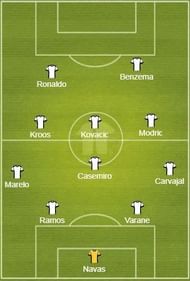
Zidane stuck to his traditional 4-4-2 diamond formation with 4 midfielders behind the front-two of Karim Benzema and Cristiano Ronaldo. The back-four was also an easy selection with all of his best defenders available. The only surprise inclusion to the side was Mateo Kovacic who made his first La Liga start in the 2017-18 season. The reason behind the decision seems justifiable as it was an attempt to blend defensive diligence with attacking flair in midfield.
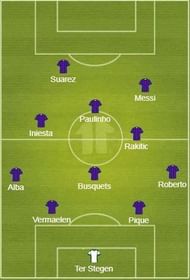
Valverde chose not to spring any surprises and went ahead with his winning combination (which is also 4-4-2 diamond). The change of system from the traditional 4-3-3 to 4-4-2 since Ousmane Dembele’s injury, has worked wonders for Barcelona. Hence it was sensible on Valverde’s part that he didn't try to fix something that wasn't broken.
Real Madrid’s dominance
It was a tale of two halves and anyone who watched only one of the halves would clearly get it wrong when trying to predict how the other half was. The first half was dominated by Los Blancos and it looked like Zidane's tactical changes were worth it as Barcelona struggled to cope with the pressure. There were a couple of tactical decisions that Madrid especially got spot-on that allowed them to dictate the tempo of the game. Let's deep dive and look into the decisions:
The man-marking
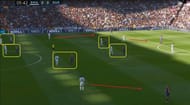
Madrid deployed man-to-man marking all over the pitch when Barcelona tried to play out from the back. Since both teams fielded a 4-4-2, man-marking wasn’t a complex task in terms assigning who marks who. The front-two of Ronaldo and Benzema pressed the centre-backs while the four midfielders of Madrid marked the four midfielders of Barcelona; Luka Modric on Andres Iniesta, Toni Kroos on Ivan Rakitic, Casemiro on Paulinho, Mateo Kovacic on Sergio Busquets.
The full-backs of the two sides were head-on against each other as both teams didn't have wingers.
As you may know, Barcelona are in their comfort zone when allowed to build-up from the back using possession play. Since Madrid deployed man-marking and high-pressure, it didn’t allow their goal-keeper Marc-Andre ter Stegen any passing options close to him. It forced the German International to go long and Barcelona aren't really comfortable with long-balls/ aerial duels.
Ter Stegen attempted 19 long passes against Madrid. His average long passes ratio per game in the league is 6. The numbers clearly indicate the change in build-up play. It helped the hosts turnover possession more often as they either won the aerial duel or the second ball from where they could initiate their attacks.
However, the man-marking pattern underwent a small change whenever Barcelona managed to overcome the pressure and enter the attacking half. Kovacic's role changed depending on the position of the ball and the opponents.

Once Barcelona overcame the pressure and entered the attacking half, Kovacic took over the tedious task of marking Lionel Messi. Madrid were aware of Messi’s movement, irrespective of whatever position he started in, and hence a player like Kovacic, who is a combination of hard-work and agility was definitely a good choice to mark the little magician. He followed Messi all over the attacking third trying to minimise the potential threat while Busquets who was originally marked by Kovacic during the build-up, was pressed by Benzema.
It was a bold move and it yielded Madrid the desired outcome as Barcelona created very few chances in the first half.
Finding pockets of space
This is something that Los Blancos did pretty well. Madrid enjoyed more possession than Barcelona in the first half owing to the marking, pressure and winning the ball back at regular intervals. Once Zidane’s men won the ball, they were quick in their transition and outpaced Barcelona numerous times on the counter. There was one particular area where they constantly found space to run onto and it was the gap between the Barcelona centre-backs and full-backs.
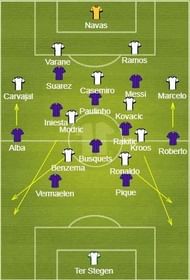
The reason for the space between the Barcelona centre-backs and full-backs is due to the 4-4-2 fielded by Valverde. Since the four midfielders of Barca and Madrid were against each other, the full-backs had only each other to take on. Hence, whenever Marcelo or Carvajal were in possession of the ball, they naturally drew Alba and Roberto towards them to be closed down. Once the space was created, it was up to Ronaldo/Kroos and Modric/Benzema to run into it depending on the situation. Madrid created numerous chances from the wide areas as they stretched Barcelona wide.
Here is an example from the first half on the left wing:
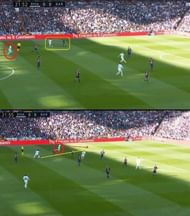
In the image above (top), Marcelo (on the ball) waited until the right-back Roberto was drawn into closing him down and Kroos (circled red) already started his run. The image in the bottom was seconds later. As you can see, once Roberto tried to close him down, space was created between Pique and Sergi Roberto. Marcelo found Kroos (circled red) with a simple through ball and it was a good opportunity for Kroos to find Ronaldo/ Benzema but Pique’s excellent slide tackle halted the attack.
Now that you saw an example on the left wing, here is another from the right wing:
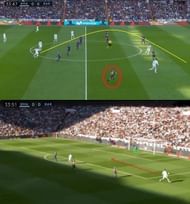
As you can see, Alba (circled red) was caught up-field while closing down his counterpart Carvajal. Thus, space is created between Vermaelen and Alba into which Ronaldo was ready to run onto. Modric who is generally the most adept at these situations, neatly lofts the ball for Ronaldo. The Ballon d'Or winner crossed the ball for Benzema to poke it in but it was again well defended by Vermaelen and Pique to see off the attack.
The club world champions constantly stretched Barcelona’s back four and created numerous chances from the wide areas. But the Catalans defended really well to keep all of these threats at bay only to send Zidane’s men into the dugout at half-time not wanting the half to end. Barcelona could also trouble Navas on two occasions thanks to their summer signing Paulinho but the Madrid goal-keeper pulled off stunning saves to keep the score 0-0.
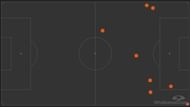
The drop in tempo in the second-half
The players stepped out of the tunnel for the second-half and the story unfolded in an entirely different manner as compared to the first-half. The Catalans seemed comfortable on the ball, their passing improved and they were able to build-up play from the back. However, the tables didn’t turn because of Carvajal’s sending-off. The league leaders already had taken control even when it was 11 vs 11.
First half
Possession: Real Madrid 52% - 48% Barcelona
Pass completion: Real Madrid 87% - 84% Barcelona
Second half (45th min to 63rd min, before the sending off)
Possession: Real Madrid 41% - 59% Barcelona
Pass completion Real Madrid 80% - 91% Barcelona
As you can see from the numbers, the game had changed even before Madrid went a man down. In fact, Barcelona took the lead 8 minutes into the second-half after a sublime counter-attacking involving Rakitic, Roberto and Suarez. Madrid deployed man-to-man marking for a majority of the first half and there are no doubts if it worked in their favour or not. However, Madrid's setup was bound to fail as it's hard to keep your levels up to such a demanding style of play for the full 90 minutes.
Ideally, it is a method of defending that needs to be used in short-stints and not for an extended period. The physical and mental toll it took on Zidane’s men was evident. It would have been all worth it if Madrid were able to take the lead in the first half as it would have allowed them to sit back and play on the counter. But unfortunately for Madrid, Barca were smart enough to see off the initial storm and waited before they pounced on their rivals in the second-half.
Another fact that suggests how good Barca have been in game management is their ability to kill off opponents in the second half after wearing them out in the first half on a regular basis. The Catalans have scored 45 goals in 17 games out of which only 14 have been scored in the first half as compared to 31 in the second half. It shows that what they did to Real Madrid is something they have been adept at this season.
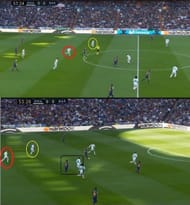
The first goal scored by Barca was a proof of Madrid’s fatigue. The problem started with Kroos’ casual pass attempt intercepted by Roberto. After a couple of passes, Busquets was in possession and he could beat Kroos with a simple turn and released Rakitic. As you can see in the image above (top), when Rakitic started the run he was on par with Modric (circled yellow) and Carvajal (circled red). In fact, both of these Madrid players are generally quicker than Rakitic while surprisingly their engines did not allow them to catch up with Croat who accelerated into the heart of Madrid’s defence.
In the image in the bottom frame, it is clear that if there was anyone who could have caught up with Suarez, then it was Carvajal as Varane was closing down Rakitic while Kovacic (in the black square) didn’t want to leave Messi free. Carvajal on another day might have caught up with Suarez but the fatigue didn’t allow him to match pace even with Rakitic. Then a simple pass was made to Roberto and Roberto squared it off on the first touch to Suarez and the Uruguayan didn’t need a second touch either, to find the back of the net.
The second goal also was a chance created owing to Carvajal’s slow tracking back which left Suarez in space to the left side of Varane. Once Suarez’s shot was saved by Navas, Madrid were all over the place inside the box with Messi, Suarez and Paulinho literally toying with them.
Navas was beaten and the ball had already gone past him, thus forcing Carvajal to become a keeper to stop Paulinho's header with a brilliant save using his hands. In truth, Carvajal could have chosen not to handle the ball as the 0-2 deficit would have chased with 11 men instead of 10. Once Madrid went a man down with a 0-2 deficit, there was no coming back despite the little fight back from substitutes Bale and Asensio. However, the Catalans were more than comfortable to finish the game off with another easy goal towards the end to make it 0-3.
Conclusion
The important lesson that needs to be learnt from the El Clasico is not only about Madrid’s plan back-firing but the new dimension that Valverde has added to Barcelona. They are not only about philosophy, possession, passing and movement but they are also about defending, absorbing pressure and pragmatism.
The league leaders showed signs of being cautious, retreating back and being pragmatic already in the away games against Juventus, Valencia and so on. But in this game, Valverde has made it absolutely clear that if the situation demands, they wouldn’t think twice to sit back and hold on to their horses before unleashing them.
Image sources: www.fullmatchreplay.com, www.whoscored.com, www.mirror.co.uk, www.this11.com
